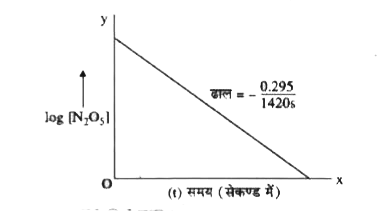गैस प्रावस्था में 318K पर N2O5 के अपघटन की [2N2O5→4NO2+O2] अभिक्रिया के आँकड़े आगे दिए गए है-
![गैस प्रावस्था में 318K पर N(2)O(5) के अपघटन की [2N(2)O(5)rarr4NO(2)+O(2)] अभिक्रिया के आँकड़े आगे दिए गए है- log[N(2)O(5)] एवं t के मध्य ग्राफ खींचिए।](https://d10lpgp6xz60nq.cloudfront.net/physics_images/SNJ_BSA_HIN_CHE_XII_P1_C04_E04_060_Q01.png)
log[N2O5] एवं t के मध्य ग्राफ खींचिए।
log[N2O5] तथा t के मध्य ग्राफ खींचने के लिए पहले N2O5 के विभिन्न मानो का log लेते है-

फिर, समय (t) तथा log[N2O5] के मध्य ग्राफ खींचते है जो कि निम्न प्रकार है-

Topper's Solved these Questions
- रासायनिक बलगतिकी BOOK - SANJEEV PUBLICATIONCHAPTER - रासायनिक बलगतिकी EXERCISE - अन्य महत्वपूर्ण प्रश्न लघुत्तरात्मक प्रश्न
12 Videos
- रासायनिक बलगतिकी BOOK - SANJEEV PUBLICATIONCHAPTER - रासायनिक बलगतिकी EXERCISE - अन्य महत्वपूर्ण प्रश्न निबन्धात्मक प्रश्न
12 Videos
- रासायनिक बलगतिकी BOOK - SANJEEV PUBLICATIONCHAPTER - रासायनिक बलगतिकी EXERCISE - पाठ्य पुस्तक के अभ्यास प्रश्न लघुत्तरात्मक प्रश्न
40 Videos
- बहुलक BOOK - SANJEEV PUBLICATIONCHAPTER - बहुलक EXERCISE - अन्य महत्त्वपूर्ण प्रश्न (निबंधात्मक प्रश्न (Esaay Type Questions)
1 Videos
- विलयन BOOK - SANJEEV PUBLICATIONCHAPTER - विलयन EXERCISE - आंकिक प्रश्न
35 Videos
Similar Questions
Valency and oxidation number of nitrogen in N2O5
View SolutionNitrogen forms largest number of oxides in which oxidation state of nitrogen varies from +1 to +5 N2O,NO,N2O3,N2O4andN2O5 respectively. The largest number of oxides are formed due to capability of forming stable multiple bonds by nitrogen with oxygen.
Q. Which of the following statements is/are correct regarding oxides of nitrogen?
View Solution
Knowledge Check
We can represent the decomposition of N2O5(g) at a fixed temperature by the following two chemical equations:
(P) 2N2O5(g)→4NO2(g)+O2(g),
Activation energy Ea
(Q) N2O5(g)→2NO2(g)+12O2(g),
Activation energy E'a then:AE1>E2BE1<E2CE1=2E2DE1=E2At the equilibrium of the reaction ,
N2O4(g)⇒2NO2(g), the observed molar mass of N2O4 is 77.70 g . The percentage dissociation of N2O4 is :-A28.4B46.7C22.4D18.4the number of moles of Cr2O27 needed to oxidise 0.136 equivalent of N2H5 through the reaction:
N2H5+Cr2O2−7→N2+Cr3+H2O is:A0.136B0.272C0.816D0.0227
The correct order of the oxidation states of nitrogen in NO,N2O,NO2 and N2O3 is :
View SolutionNumber of acidic oxides among the following is:
(a) N2O (b) NO (c) N2O3 (d) N2O4 (e) N2O5 (f) P4O6
(g) P4O10 (h) SO3 (i) B2O3 (j) CO
View SolutionThe rate of reaction.
2N2O5→4NO2+O2
can be written in three ways.
−d[N2O5]dt=k[N2O5]
d[N2O5]dt=(k′[N2O5])
d[O2]dt=(k′[N2O5])
The relation between k and k′ are:
View Solution2N2O5→4NO2+O2
If −D[N2O5]dt=k1[N2O5]
d[NO2]dt=k2[N2O5]
[O2]dt=k3[N2O5]
What is the relation between k1,k2 and k3?.
View Solution
